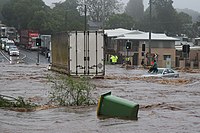
Photo from wikipedia
Abstract. Climate change is projected to increase flood risks in West Africa. The EU Horizon 2020 project FANFAR co-designed a pre-operational flood forecasting and alert system for West Africa in… Click to show full abstract
Abstract. Climate change is projected to increase flood risks in West Africa. The EU Horizon 2020 project FANFAR co-designed a pre-operational flood forecasting and alert system for West Africa in three lively workshops with 50–60 stakeholders, adopting a transdisciplinary framework from Multi-Criteria Decision Analysis (MCDA). We aimed to (i) exemplify MCDA as a structured transdisciplinary process; (ii) prioritize suitable FANFAR system configurations; and (iii) document and discuss empirical evidence. We used various interactive problem structuring methods in stakeholder sessions to generate 10 objectives and design 11 FANFAR system configurations. The non-additive MCDA model combined expert predictions about system performance with stakeholder preferences elicited in group sessions. All groups preferred a system producing accurate, clear, and accessible flood risk information that reaches recipients well before floods. To receive this, most groups would trade off higher operation and maintenance costs, development time, and implementing several languages. We accounted for uncertainty in expert predictions with Monte Carlo simulation. Sensitivity analyses tested the results’ robustness for changing MCDA aggregation models and diverging stakeholder preferences. Despite many uncertainties, three FANFAR system configurations achieved 63–70 % of the ideal case over all objectives in all stakeholder groups, and outperformed other options in cost-benefit visualizations. Stakeholders designed these best options to work reliably under difficult West African conditions rather than incorporating many advanced features. The current FANFAR system combines important features increasing system performance. Most respondents of a small online survey are satisfied, and willing to use the system in future. We discuss our learning drawing from design principles of transdisciplinary research. We attempted to over-come “unbalanced ownership” and “insufficient legitimacy” by including key West African institutions as consortium partners and carrying out co-design workshops with mandated representatives from 17 countries. MCDA overcomes challenges such as “lack of technical integration”, or “vagueness and ambiguity of results”. Whether FANFAR will have a “societal impact” depends on long term financing and system uptake by West African institutions after termination of EU sponsoring. We hope that our promising results will have a “scientific impact” and motivate further stakeholder engagement in hydrology research.
Journal Title: Hydrology and Earth System Sciences Discussions
Year Published: 2021
Link to full text (if available)
Share on Social Media: Sign Up to like & get
recommendations!